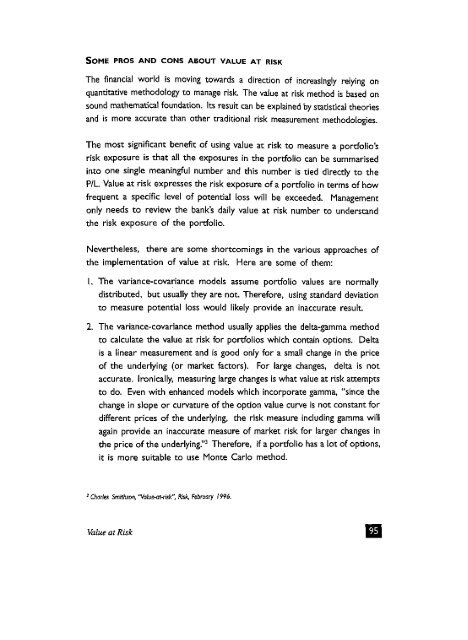Derivatives in Plain Words by Frederic Lau, with a ... - HKU Libraries
Derivatives in Plain Words by Frederic Lau, with a ... - HKU Libraries
Derivatives in Plain Words by Frederic Lau, with a ... - HKU Libraries
- No tags were found...
You also want an ePaper? Increase the reach of your titles
YUMPU automatically turns print PDFs into web optimized ePapers that Google loves.
ABOUT VALUE ATThe f<strong>in</strong>ancial world is mov<strong>in</strong>g towards a direction of <strong>in</strong>creas<strong>in</strong>gly rely<strong>in</strong>g onquantitative methodology to manage risk. The value at risk method is based onsound mathematical foundation. Its result can be expla<strong>in</strong>ed <strong>by</strong> statistical theoriesand is more accurate than other traditional risk measurement methodologies.The most significant benefit of us<strong>in</strong>g value at risk to measure a portfolio'srisk exposure is that all the exposures <strong>in</strong> the portfolio can be summarised<strong>in</strong>to one s<strong>in</strong>gle mean<strong>in</strong>gful number and this number is tied directly to theP/L Value at risk expresses the risk exposure of a portfolio <strong>in</strong> terms of howfrequent a specific level of potential loss will be exceeded. Managementonly needs to review the bank's daily value at risk number to understandthe risk exposure of the portfolio.Nevertheless, there are some shortcom<strong>in</strong>gs <strong>in</strong> the various approaches ofthe implementation of value at risk. Here are some of them:1. The variance-covariance models assume portfolio values are normallydistributed, but usually they are not. Therefore, us<strong>in</strong>g standard deviationto measure potential loss would likely provide an <strong>in</strong>accurate result.2. The variance-covariance method usually applies the delta-gamma methodto calculate the value at risk for portfolios which conta<strong>in</strong> options. Deltais a l<strong>in</strong>ear measurement and is good only for a small change <strong>in</strong> the priceof the underly<strong>in</strong>g (or market factors). For large changes, delta is notaccurate. Ironically, measur<strong>in</strong>g large changes is what value at risk attemptsto do. Even <strong>with</strong> enhanced models which <strong>in</strong>corporate gamma, "s<strong>in</strong>ce thechange <strong>in</strong> slope or curvature of the option value curve is not constant fordifferent prices of the underly<strong>in</strong>g, the risk measure <strong>in</strong>clud<strong>in</strong>g gamma willaga<strong>in</strong> provide an <strong>in</strong>accurate measure of market risk for larger changes <strong>in</strong>the price of the underly<strong>in</strong>g" 3 Therefore, if a portfolio has a lot of options,it is more suitable to use Monte Carlo method.3 Charles Smithson, "Va/ue-at-r/s/c" Risk, February 1996.Value at Risk
















